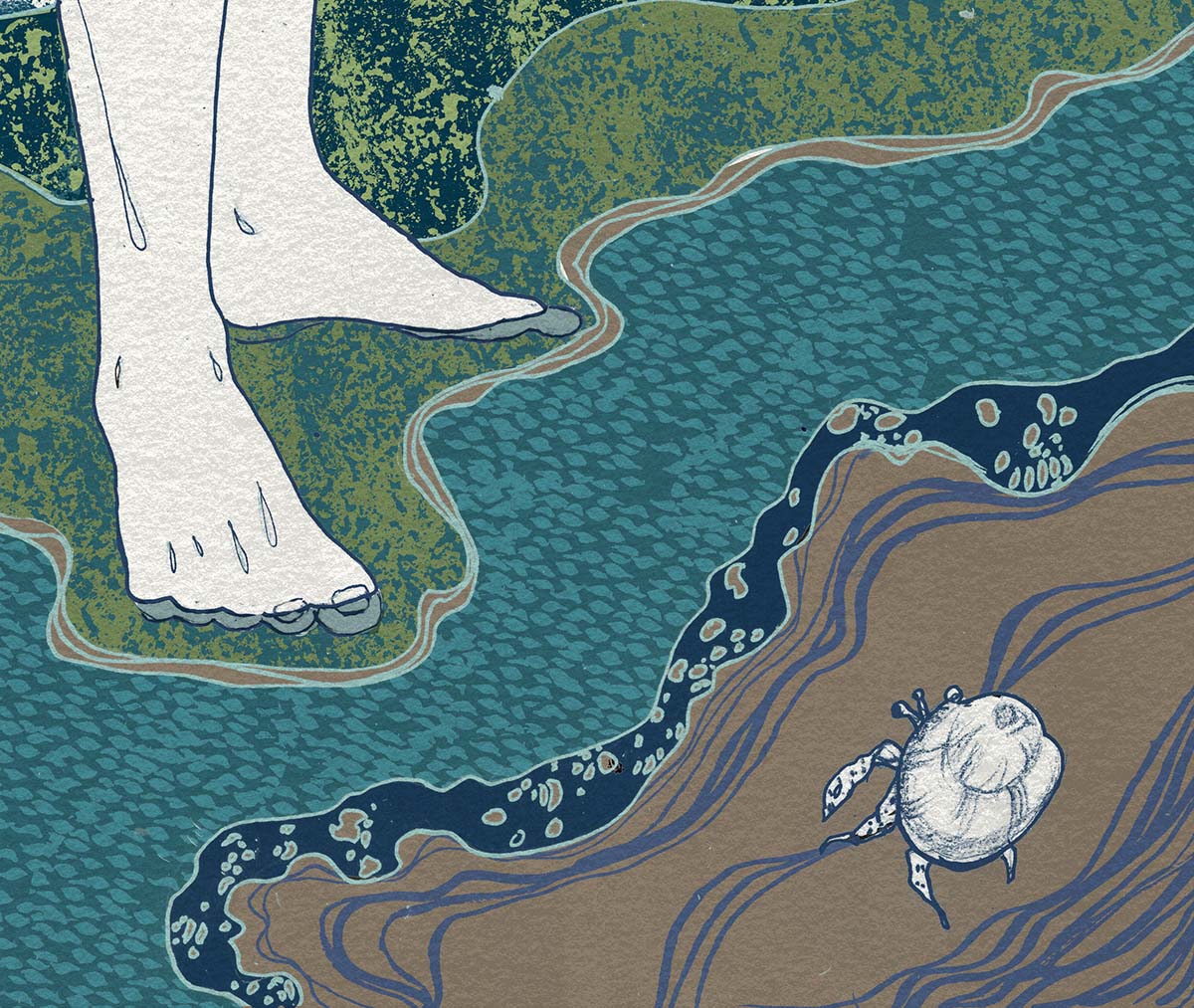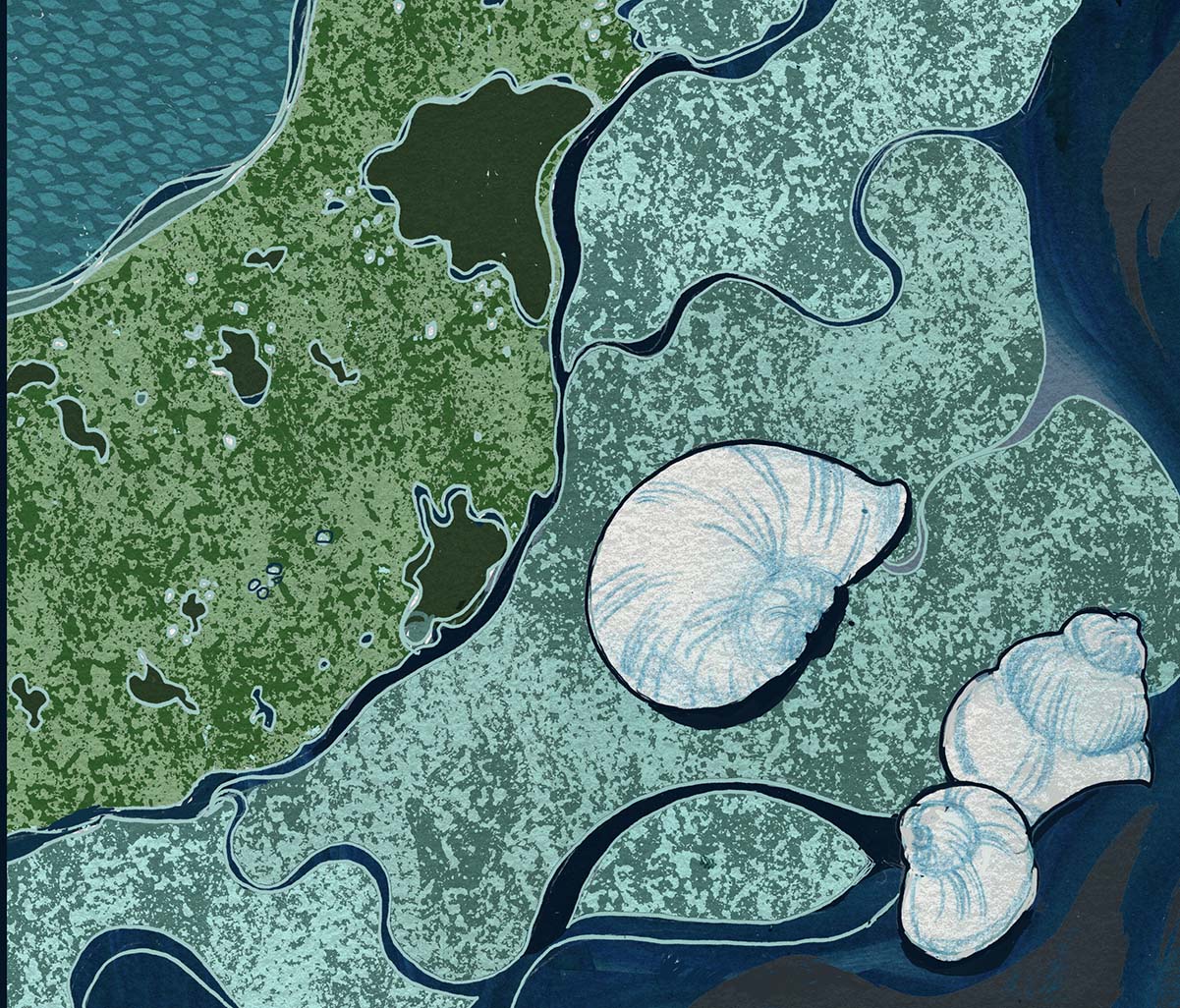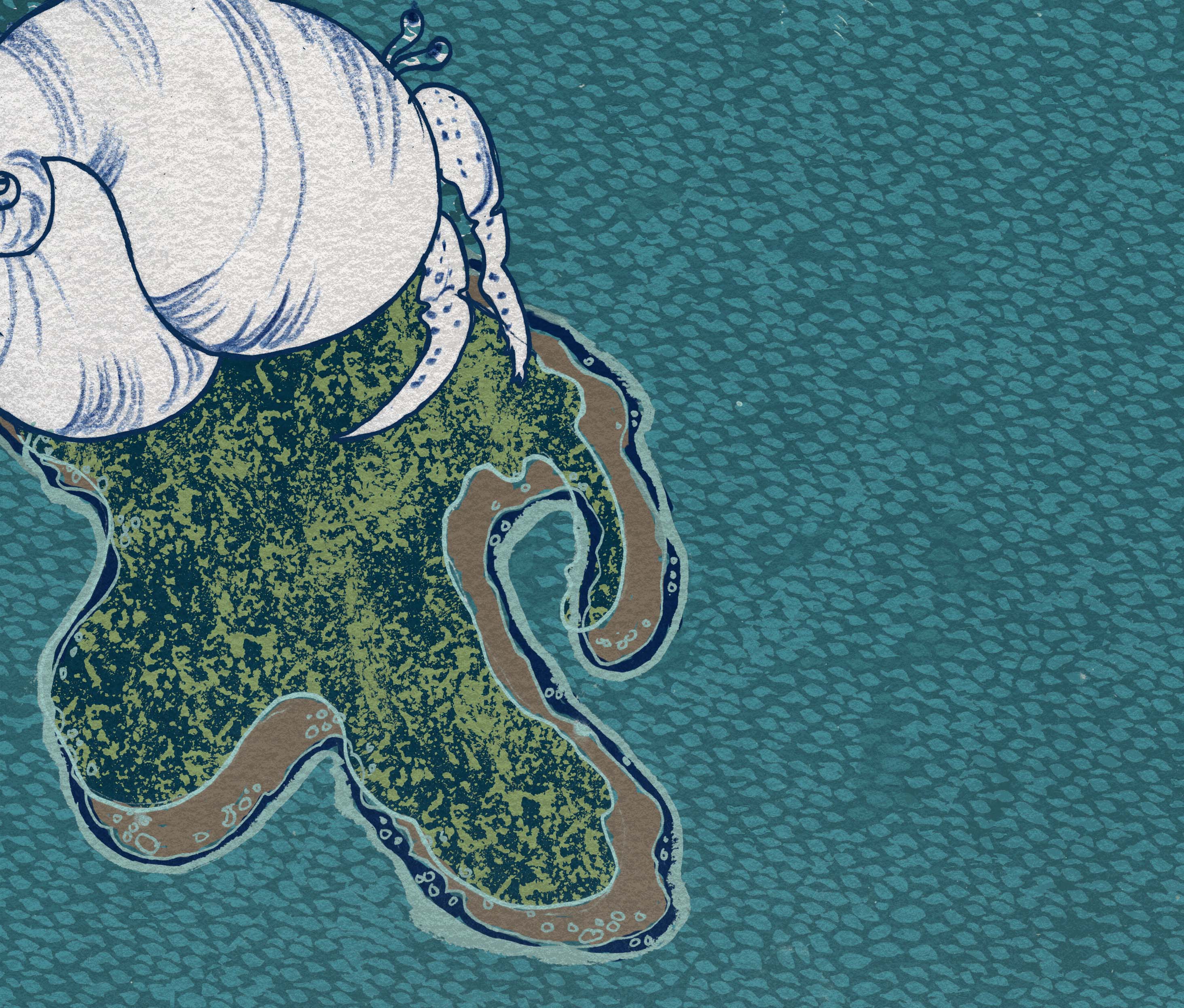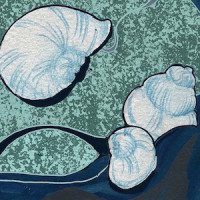The water is warm and ankle-deep. My sisters and I swam in it six hours ago and I know it’s salty, but low tide in Cape Cod Bay is nothing you’d want to put in your mouth. That’s irrational, because everything that was there before is there now, but seeing it makes a difference. The tide-flat is studded with slimy, pointy-shelled snails, so many that we can’t help stepping on them. Algae of several colors and gelatinous egg cases waver with our steps. “What are those from again?” I ask my mom. “I knew last year,” she says.
We were here together, taking this walk, thirty years ago and more. But what has changed, and how can we be trusted to know? We can’t even remember last summer. Plenty of hermit crabs scuttle underwater, as they did when my cousin and I collected them in buckets at age eight, but are more of them in smaller shells? The number of Nassarius obsoletus—those snails we shudder to tread on, each with its single turd-like feeler—is high, but is it higher? And if we could answer those questions, we still wouldn’t know much unless we knew why.
Population density of Nassarius obsoletus, says a 2013 paper, is tentatively correlated with nutrient enrichment in the water: algae growth stimulated by, among other things, warmer water, nitrogen fertilizers, and sewage. Like all marine waters, Cape Cod Bay is also vulnerable to the effects of greenhouse gases in the atmosphere: ocean acidification, which eats away at baby mollusks’ shells; changes in ocean currents based on air temperature, which can affect the temperature and salinity of the water and who can live in it; and the way sea level rise may affect ecosystems, especially at the current edges of the water. Some species may thrive, some may disappear; some may thrive at first and then disappear. Some may move in from the south, seeking cooler waters or dodging new predators: Cape Cod Bay is part of the Gulf of Maine, which has seen an influx of more southerly fish like red hake and ocean sunfish. Some may move away north for the same reasons. And every life that moves, or dies, or multiplies will have an effect of some sort on the lives around it, a different effect than the one it had before.
changes in ocean currents based on air temperature, which can affect the temperature and salinity of the water and who can live in it; and the way sea level rise may affect ecosystems, especially at the current edges of the water. Some species may thrive, some may disappear; some may thrive at first and then disappear. Some may move in from the south, seeking cooler waters or dodging new predators: Cape Cod Bay is part of the Gulf of Maine, which has seen an influx of more southerly fish like red hake and ocean sunfish. Some may move away north for the same reasons. And every life that moves, or dies, or multiplies will have an effect of some sort on the lives around it, a different effect than the one it had before.
But I had to look most of this up. I trust my eyes, but not what I do or know as a result of what they see. We walk across languorous ripples and choppy ones, pick our way around oyster and razor clam shells. We call eager attention, as we always have: look, those hermit crabs are fighting. Look, a skate egg case—that’s the first one I’ve seen this year. Look at these little sandpiper tracks and these big seagull tracks. Here and elsewhere, season after season, my family taught me to see and to take delight in seeing the world, human and nonhuman, going about its daily occasions. We speculate about the reasons why some of the ripples are languorous and others choppy; from overheard snippets of conversation, we gleefully extrapolate relationships and subtexts.
We do this for the pleasure of it, not with any goal in mind, but actions without goals can still have outcomes. We see this in the fertilizers running down into the Bay every time it rains, in the temperatures that rise because of the way we grow the food we have to eat and generate the electricity we use. What of ourselves, what in our vision and the way it guides our action, do we reinforce each time? When I say, “I’m seeing a lot more dead little crabs this year,” my mom says quickly, “I don’t know if there’s more.” My sister, who knows how I feel about these things, tells me she’s seen other barndoor skate egg cases when I point one out: “So there are some,” she says, “not just one.”
It does make me feel better, but that’s irrational too, because I don’t know what it means. Should I be glad I’ve seen three dead horseshoe crabs because that suggests there are some alive close by, or should the sight plunge me deeper into grief and fear? How do I read this book, a book not written with me in mind, a book it’s arguably easier for me to burn than to understand?
As much as my family loves to notice things, we hate equally to miss things. Since there are five of us, often one will talk and another will only catch the tail of what was said. This has always been true, but it’s become truer more recently as my mom starts to lose the edges of her hearing. On other walks, we’ve discussed the birdsongs I can hear and she can’t,  but I didn’t know until this trip that it was frustrating her. My dad took her in his arms and said, “The missing part is not so bad. We’ll always catch you up.” My dad must have comforted my mom many, many times over their nearly forty years together, but I don’t think I’ve ever seen it.
but I didn’t know until this trip that it was frustrating her. My dad took her in his arms and said, “The missing part is not so bad. We’ll always catch you up.” My dad must have comforted my mom many, many times over their nearly forty years together, but I don’t think I’ve ever seen it.
We say “always” and mean it entirely. We look out over the tide-flat and feel we could walk forever—that broad expanse, that shining sheet, that stink. The Laurentide Ice Sheet left Cape Cod behind at the end of the last ice age, dropping its burden of sand, silt, and clay, between sixteen and twenty thousand years ago. My mind can’t hear those timescales, not really. The indented coastline of Eastham is what remains, the USGS says, of headlands and embayments left by the glacier. Before Nauset and Wampanoag people fished and clammed there, Cape Cod Bay was a glacial lake, between fifty and eighty feet above present sea level.
The colonists brought disease and violence to the Wampanoag and Nauset peoples. Warming global temperatures are projected to raise seas around the Cape as little as eight inches and as much as six feet over the next lifetime or so. Yet my mother wants to reassure me, or to reassure herself, I can’t quite tell. “It’s nice to see that things are reproducing as they should,” she says when I point out a whelk egg case like a long accordion, the first I’ve seen in three days. Am I making it up that my cousin and I used to find multiple ones in a day, or was that in a season? Time collapses in the rear-view mirror. How can I know what’s memory and what’s nostalgia? I’m confident that there’s less, by far, of what the same cousin taught me to call “asshole glass” because only assholes dropped it on the beach—beautiful, sea-worn, but a sign of disrespect. Still, on the way back toward the house my mom and I pick up a beer can, a twist of nylon rope, a couple of wrappers, and a plastic wineglass; we walk back carrying a goblet of garbage, with no free hands.
Cataloguing is no substitute for correlation. The makers of the nature guides, the counters of stamens and leg bristles, the coiners and refiners of taxonomic designations—Nassarius obsoletus used to be Ilynassa obsolete—do their work with an admirable degree of obsessive love and careful expertise, but they too are working with what they’ve been taught to know and recognize as important. North Americans’ cultural habits lead us to look at things in isolation rather than relationship; examinations of other cultures’ taxonomies reveals different clusters of specificity, different applications of knowledge. I love to catalogue, but I must also correlate, as what’s available for correlation changes, and before it disappears, or I do.
My parents are both artists; they spend their days re-teaching themselves to see as if they didn’t already know. My mom points this out to me in a book she’s brought with her, Henry Miller writing about watercolor painting; she shows it to me delightedly, as if it were something she found on the beach, as if it were new to her; she makes it new to her again. They made expansive my capacity to notice and to speculate, but if everything is new, how can you know what has changed, or what you need to change?  Whatever my parents didn’t do, whatever my ancestors did, it’s on me to decide what I will do, and then to do it—but that decision needs to be informed.
Whatever my parents didn’t do, whatever my ancestors did, it’s on me to decide what I will do, and then to do it—but that decision needs to be informed.
When a snail dies and is eaten (by bacteria, by other snails, you name it) a hermit crab can take over its empty shell. I knew that even when my cousin and I were putting them into buckets. I didn’t know then, and don’t know now, whether I’m seeing more hermit crabs in smaller shells because there are fewer larger snails in Cape Cod Bay; if that’s true, whether it’s because there are more Nassarius obsoletus, or whether that’s a coincidence, or whether the increase in one and the decrease in the other have a single cause; whether that cause is closely anthropogenic (fertilizers, sewage), more distantly anthropogenic (warmer waters, ocean acidification), or the result of a process having little to do with humans at all; whether hermit crabs have to reach a certain size in order to reproduce; whether it would help if I threw a bunch of large empty snail shells into the bay. And even if I knew all of that, I still wouldn’t know what, if anything, I could do to protect them from vanishing, whether protecting them from vanishing would be the “right” thing to do. I know I love them: their delicate claws, their scuttle, their rage when lifted, their scavenging services. I know that love is not enough.
Robin Wall Kimmerer writes of learning her Potawatomi language: “A bay is a noun only if water is dead … the verb wiikwegama releases the water from bondage and lets it live. ‘To be a bay’ holds the wonder that, for this moment, the living water has decided to shelter itself between these shores, conversing with cedar roots and a flock of baby mergansers,” or in the case of Cape Cod Bay, bringing food to clams, slowing the wind over its surface a little, tolerating snails and people—for now. The possibility of death and degradation is built into living complexity; the possibility of familiarity, of intimacy, is built into strangeness, though it ebbs and flows with changes in what there is to know.
“Extinction Is Forever” said the posters in my childhood classrooms. We are not good at forever. Our human “always” is limited—by the spans of our lives, by the genuine weakness of our memory and the deliberate omissions of our history. When we say always, even about love, we’re wrong. But we are not lying.
***
Rumpus original art by Kara Y. Frame.
***
Works Consulted:
Johnson, David Samuel and Short, Meghan I: “Chronic Nutrient Enrichment Increases the Density and Biomass of the Mudsnail Nassarius obsoletus.” Estuaries and Coasts (2013) 36:28-35. Available online through the Marine Biological Laboratory at Woods Hole.
Center for Coastal Studies, “Cape Cod Bay.”
United States Geological Survey, “Geologic History of Cape Cod, Massachusetts.” Web page by Donna Newman at the Marine Biological Laboratory at Woods Hole.
Murdukhayeva, Angelica et al, “Assessment of Inundation Risk and Sea Level Rise and Storm Surge in Northeastern Coastal National Parks. Journal of Coastal Research, 00(0), 000-000. Coconut Creek, FL. Available online through the Environmental Data Center at the University of Rhode Island.
Robin Wall Kimmerer, “Learning the Grammar of Animacy” from Braiding Sweetgrass: Indigenous Wisdom, Scientific Knowledge and the Teachings of Plants by Robin Wall Kimmerer (Minneapolis: Milkweed Editions, 2013). Republished in Moon Magazine, January 2015.




